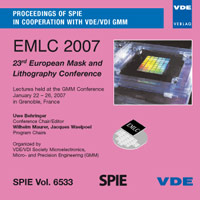Improvement of Model Kernel Representation in Process Simulation by Taking Pattern Correlation into account
Konferenz: EMLC 2007 - 23rd European Mask and Lithography Conference
22.01.2007 - 26.01.2007 in Grenoble, France
Tagungsband: EMLC 2007
Seiten: 9Sprache: EnglischTyp: PDF
Persönliche VDE-Mitglieder erhalten auf diesen Artikel 10% Rabatt
Autoren:
Li, Jianliang; Yan, Qiliang; Melvin III, Lawrence S. (Synopsys Inc., 2025 NW Cornelius Pass Rd., Hillsboro OR 97124, USA)
Inhalt:
In the modern photolithography simulation, the computation demand on resolution enhancement techniques (RETs) and optical proximity corrections (OPCs) is proportional to the simulation runtime of the model, which is dependant on the number of the kernels retained with the constrain of the model accuracy. Thus, it is essential to retain as few kernels as possible in the model calibration. Traditionally, the kernels are retained based upon their contribution to the aerial image, which is solely determined by the magnitudes of the eigenvalues. This method works well for arbitrary photolithography masks. However, real masks are never arbitrary and random. Instead, they have regular shapes and arrangements as governed by design rules, indicating the contributions from the retained kernels are statistically correlated to each other. By taking such correlations into account, the system representation can be improved to contain fewer Kernels for constant model accuracy. In this paper, the mathematical derivation of the pattern correlation concept is discussed and the concept is applied to a poly-silicon layer illuminated by a Quasar optical system with λ = 193 nm and NA = 0.8. Significant improvement of model kernel representation is observed, 12 improved kernels vs 20 original kernels, and the new methodology is justified by comparing the difference of the aerial image intensities between the full kernel representation and the retained kernels representation at sampling points.


